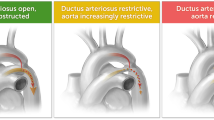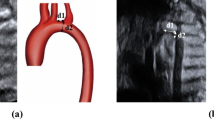Abstract
Objective:
To determine normal four-extremity blood pressure (BP) in the neonatal intensive care unit (NICU) at birth and the utility of upper (UE) and lower extremity (LE) BP difference to screen for coarctation of the aorta (Co-A) and interrupted the aortic arch (IAA).
Study Design:
Retrospective study of BP at birth (n=866), and case–control study of Co-A/IAA infants and matched controls (1:2).
Result:
Although BP increased with gestational age (R2=0.3, P<0.0001), the pressure gradient between UE and LE did not change with gestation (P=0.68). Forty-six cases of Co-A/IAA were identified, with 92 controls. Pressure gradient was significantly higher in patients with Co-A/IAA (7.6±14.8 versus 0.4±10 mm Hg, P=0.004). However, there was overlap between cases and controls resulting in low sensitivity (41.3% with ⩾10 mm Hg gradient cutoff).
Conclusion:
Evaluation of UE–LE BP gradient at birth is a poor screening test for Co-A/IAA with low sensitivity. Repeating four-limb BP after ductal closure at 24 to 48 h along with SpO2 screening for critical congenital heart disease may increase sensitivity.
This is a preview of subscription content, access via your institution
Access options
Subscribe to this journal
Receive 12 print issues and online access
$259.00 per year
only $21.58 per issue
Buy this article
- Purchase on Springer Link
- Instant access to full article PDF
Prices may be subject to local taxes which are calculated during checkout




Similar content being viewed by others
References
Mahle WT, Newburger JW, Matherne GP, Smith FC, Hoke TR et al. Role of pulse oximetry in examining newborns for congenital heart disease: a scientific statement from the AHA and AAP. Pediatrics 2009; 124 (2): 823–836.
Hoschtitzky JA, Anderson RH, Elliott MJ . Aortic Coarctation and Interrupted Aortic Arch. In: Price G (ed). Paediatric Cardiology, 3rd edn, Vol. 2010. Churchill Livingston/Elsevier Ltd: Philadelphia, PA, USA, 2009; pp 945–966.
Brown ML, Burkhart HM, Connolly HM, Dearani JA, Cetta F, Li Z et al. Coarctation of the Aorta: Life-long surveillance is mandatory following surgical repair. JACC 2013; 62 (11): 1020–1025.
Abott ME . Statistical study and historical retrospect of 200 recorded cases, with autopsy, of stenosis or obliteration of the descending arch in subjects above the age of two years. Am Heart J 1928; 4 (392–421): 574–618.
Celoria GC, Patton RB . Congenital absence of the aortic arch. Am Heart J 1959; 58: 407–413.
Mishra PK . Management strategies for interrupted aortic arch with associated anomalies. Eur J Cardiothorac Surg 35: 569–576.
Webb GD, Smallhorn JF, Therrien J, Redington AN . Congenital Heart Disease. In: Mann DL (ed). Braunwald's Heart Disease: a Textbook of Cardiovascular Medicine, 10th edn, Vol. 1. Saunders: Philadelphia, PA, USA, 2015; pp 1391–1445.
Park MK, Lee DH . Normative arm and calf blood pressure values in the newborn. Pediatrics 1989; 83 (2): 240–243.
Hulman S, Edwards R, Chen YQ, Polansky M, Falkner B . Blood pressure patterns in the first three days of life. J Perinatol 1991; 11 (3): 231–234.
Weindling AM, Bentham J . Blood pressure in the neonate. Acta Paediatr 2005; 94 (2): 138–142.
O’Shea J, Dempsey EM . A comparison of blood pressure measurements in newborns. Am J Perinatol 2009; 26: 113–116.
Kemper AR, Mahle WT, Martin GR, Cooley WC, Kumar P, Morrow WR et al. Strategies for implementing screening for critical congenital heart disease. Pediatrics 2011; 128 (5): e1259–e1267.
Muppidi S, Ngeny G, Onwauayi A . Coarctation of aorta with normal blood pressure. J Natl Med Assoc 2011; 103 (2): 173–175.
Vogel M, Vernon MM, McElhinney DB, Brown DW, Colan SD, Tworetzky W . Fetal diagnosis of interrupted aortic arch. Am J Cardiol 2010; 105 (5): 727–734.
Lannering K, Bartos M, Mellander M . Late diagnosis of coarctation despite prenatal ultrasound and postnatal pulse oximetry. Pediatrics 2015; 136 (2): e407–e412.
de-Wahl GA, Wennergren M, Sandberg K, Mellander M, Bejlum C, Inganäs L et al. Impact of pulse oximetry screening on detection of duct-dependent congenital heart disease: a Swedish prospective screening study in 39,821 newborns. Br Med J 2009; 338: a3037.
Rahiala E, Tikanoja T . Non-invasive blood pressure measurements and aortic blood flow velocity in neonates. Early Hum Dev 1997; 49 (2): 107–112.
Crapanzano MS, Strong WB, Newman IR, Hixon RL, Casal D, Linder CW . Calf blood pressure: clinical implications and correlations with arm blood pressure in infants and young children. Pediatrics 1996; 97 (2): 220–224.
Rahiala E, Tikanoja T . Suspicion of aortic coarctation in an outpatient clinic: how should blood pressure measurements be performed? Clin Physiol 2001; 21 (1): 100–104.
Crossland DS, Furness DC, Abu-Harb M, Sadagopan SN, Wren C . Variability of four limb blood pressure in normal neonates. Arch Dis Child Fetal Neonatal Ed 2004; 89: F325–F327.
Boelke KL, Hokanson JS . Blood pressure screening for critical congenital heart disease in neonates. Pediatr Cardiol 2014; 35: 1349–1355.
Park MK, Lee DH, Johnson GA . Oscillometric blood pressures in the arm, thigh and calf in healthy children and those with coarctation. Pediatrics 1993; 91 (4): 761–765.
Acknowledgements
This study was funded by 5 R01 HD072929—(SL).
Author information
Authors and Affiliations
Corresponding author
Ethics declarations
Competing interests
One of the authors, Dr Lakshminrusimha, was supported by NIH (R01 HD072929) during the study period. This grant reviews optimal oxygen saturation in two-lamb models of neonatal acute lung injury. He is also the alternate principal investigator for the Rochester-Buffalo site for the NICHD neonatal research network. The remaining authors declare no conflicts of interest.
Rights and permissions
About this article
Cite this article
Patankar, N., Fernandes, N., Kumar, K. et al. Does measurement of four-limb blood pressures at birth improve detection of aortic arch anomalies?. J Perinatol 36, 376–380 (2016). https://doi.org/10.1038/jp.2015.203
Received:
Revised:
Accepted:
Published:
Issue Date:
DOI: https://doi.org/10.1038/jp.2015.203
This article is cited by
-
Arch watch: current approaches and opportunities for improvement
Journal of Perinatology (2024)
-
Four-Limb Blood Pressure Measurement with an Oscillometric Device: a Tool for Diagnosing Peripheral Vascular Disease
Current Hypertension Reports (2019)



